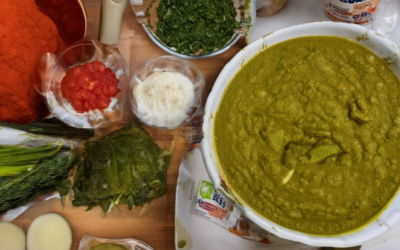Mole negro, a beloved dish in Mexican cuisine, is more than just a traditional recipe—it’s a flavorful journey that combines rich history with culinary artistry. Known for its deep, complex flavors, mole negro is a staple in Oaxacan cooking and has gained international acclaim for its versatility and richness. Whether you’re a seasoned chef or new to the kitchen, preparing mole negro can elevate your meals to new heights. This guide delves into the essential ingredients, step-by-step preparation methods, and creative uses for mole negro sauce, ensuring you get an authentic and delicious result every time. From understanding the unique characteristics of mole negro compared to other mole varieties to learning how to store it properly for maximum shelf life, this comprehensive resource covers everything you need to know to master the art of preparing mole negro. Discover the secrets behind this iconic dish and how it can transform your dining experience.

What to Do with Mole Negro?
Mole negro, a rich and complex Oaxacan sauce, offers versatile uses beyond simply serving as a condiment. Here are several creative ways to incorporate mole negro into your culinary repertoire:
- Serving as a Sauce: The traditional use is drizzling mole negro over grilled chicken, roasted turkey, or pork chops for a flavorful enhancement.
- Marinades: Use mole negro as a base for meat marinades to infuse deep, aromatic flavors before cooking.
- Soups and Stews: Incorporate mole negro into beef stew or bean soups to add layers of earthy depth and complexity.
- Dipping Sauces: Pair mole negro with tlayudas (Oaxacan-style pizzas) or as a dipping sauce for empanadas and taquitos.
- Small Plates and Appetizers: Create a mole negro-themed platter featuring proteins, rice, beans, and tortillas for a hearty meal.
- Cocktails: Experiment with mole negro in innovative cocktails, pairing it with spirits like rum or tequila for a unique twist.
- Desserts: Add mole negro to chocolate cakes or mousses for a sophisticated dessert option, though this is less common.
- Vegetarian Options: Use mole negro as a sauce for plant-based proteins like seitan or tempeh to cater to diverse dietary needs.
Explore these ideas to fully appreciate the versatility of mole negro in your kitchen!
How Long Does Mole Negro Last in the Fridge?
Mole negro, a rich and complex sauce featuring dark chocolate and black chili, has a notable shelf life when stored properly. Once the vacuum seal is broken, it can be refrigerated for up to 10 days. Proper storage in an airtight container helps preserve its flavor and texture.
- Store in an airtight container or jar to prevent oxidation and contamination.
- Refrigerate after opening to slow down spoilage.
- Use within 10 days for best quality and taste.
For extended freshness, consider making smaller batches and freezing portions in ice cube trays or freezer-safe containers. Defrost in the refrigerator before using.

What is the difference between mole poblano and mole negro?
Mole poblano and mole negro are two distinct types of mole sauces, both originating from Mexico and commonly used as dips for various dishes. While they share similarities, there are notable differences in their ingredients, preparation methods, and textures.
- Origin and History: Mole negro originated in the state of Oaxaca and is influenced by pre-Columbian and Spanish culinary traditions. Mole poblano, on the other hand, is a more modern creation, developed in Puebla.
- Ingredients: – Mole Poblano: Typically consists of a base of tomatoes, onions, garlic, and a small amount of chocolate, along with various spices and herbs. It is usually less sweet. – Mole Negro: Includes a larger proportion of sugar or piloncillo (a type of unrefined sugar), giving it a sweeter flavor. It also incorporates black pepper, which gives it its dark color and distinctive name.
- Color: Mole negro gets its dark color from the addition of black pepper, whereas mole poblano may appear reddish due to the presence of tomatoes and chili peppers.
- Texture: Mole negro tends to be thicker and smoother, almost like a velvety sauce. Mole poblano, while still rich, has a slightly thinner consistency and a more complex flavor profile.
- Regional Variations: Mole negro is particularly popular in the southern regions of Mexico, while mole poblano is more associated with central Mexico and is often served with dishes like carnitas (fried pork) or pollo al mole (chicken in mole sauce).
- Culinary Uses: Mole negro is often used for desserts or sweet dishes, while mole poblano is more commonly paired with savory dishes like chicken, pork, or beef.
Both types of mole are labor-intensive to prepare, requiring hours of simmering to develop their deep, complex flavors. Whether you’re looking for a rich, savory option or a sweeter, darker variety, both mole poblano and mole negro offer unique ways to enhance your dining experience with authentic Mexican cuisine.

What Does Mole Negro Sauce Taste Like?
Mole Negro sauce is a rich, velvety condiment that captivates the senses with its perfect balance of flavors. Crafted by experts at Panito Mole, this sauce combines the complexity of five different chili peppers with the earthy depth of dark chocolate, the tanginess of tomatillos, and the subtle sweetness of dried fruits and nuts. The result is a sauce that is as aromatic as it is delicious.
- Smoky and Earthy: The sauce has a deep, smoky flavor reminiscent of charred wood, achieved through the use of dried chipotle peppers and Oaxacan-style black beans.
- Sweet and Complex: Its sweetness comes from dried figs, raisins, and a touch of brown sugar, creating a harmonious blend of flavors that isn’t overpoweringly sweet but rather balanced and elegant.
- Spicy but Mellow: While it carries significant heat, the spice is tempered by the cooling effect of avocado and the creamy texture of the sauce, making it less intense than traditional chili-based sauces.
- Rich and Velvety: The sauce has a luxurious mouthfeel, achieved through the addition of heavy cream and a carefully blended mixture of spices and nuts.
- Finish: The lingering finish is warm and slightly sweet, leaving a satisfying impression on the palate.
Mole Negro is versatile enough to elevate a variety of dishes, from grilled meats to traditional Mexican dishes like carnitas and pan-fried chicken. At Panito Mole, we believe that a great sauce shouldn’t overshadow the food it’s served with, which is why our Mole Negro is designed to complement rather than dominate.
Discover the true essence of Oaxacan cuisine with our premium Mole Negro sauce. Visit Panito Mole today to explore our collection of authentic mole recipes and learn how to create restaurant-quality dishes at home.
How to Use Mexican Mole Sauce
Mexican mole sauce is a rich, complex condiment that adds depth to a variety of dishes. Here’s how to use it effectively:
- Understanding Mole Sauce Types: Mole sauce comes in various forms, from mild to spicy. Common types include:
- Rojo (red): Spicy and vibrant, perfect for meat dishes.
- Verde (green): Herby and slightly spicy, often paired with chicken.
- Azul (blue): Made with blue corn and squash seeds, offering a unique flavor.
- Poultry (chicken or turkey)
- Meat (beef, pork)
- Fish (e.g., salmon or cod)
- As a Dip: Serve with tortilla chips, crispy potatoes, or fresh vegetables.
- In Enchiladas: Mix mole into the filling for a burst of flavor.
- On Tacos: Drizzle mole over carnitas or chicken tacos.
- With Breakfast: Spoon mole over eggs, huevos rancheros, or chilaquiles.
- Bread or crackers for dipping.
- Grains like quinoa or rice for a balanced meal.
- Vegetables like zucchini or squash for a vegetarian option.
- Start with a small amount and adjust to taste.
- Heat gently to warm the sauce without burning.
- For a creamier texture, mix with a bit of broth or sour cream.
Explore the rich flavors of mole sauce by experimenting with these ideas and incorporating it into your favorite dishes!
For more authentic Mexican recipes and mole sauce inspiration, visit Panito Mole .

What Makes Mole Negro Black?
Mole negro is known for its deep, rich color, which primarily comes from the process of roasting dried chiles until they become black and crispy. This technique imparts a smoky, earthy flavor that forms the foundation of the sauce. The black color is achieved through the charring of these chiles, contributing to both the visual appeal and the complex taste profile of the dish.The preparation involves combining several ingredients, including various types of dried chiles (such as ancho, pasilla, and morita), roasted nuts (like almonds, pecans, and peanuts), dried fruits (raisins and figs), and spices (cumin, coriander, and cinnamon). Additionally, Mexican chocolate is a key component, adding a subtle sweetness and richness to balance the heat from the chiles.This blend of ingredients creates a multi-layered flavor, with the charred chiles providing the bold backbone, the nuts offering a crunchy texture, the fruits adding depth, and the spices enhancing warmth. The chocolate further rounds out the sauce, preventing it from being overly spicy while enriching the overall taste.




0 Comments